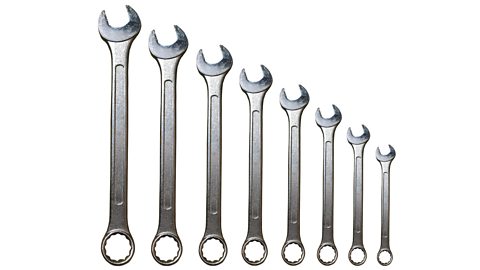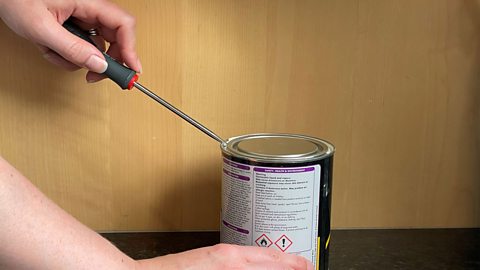Key points
When a force is applied to an object it can cause it to rotate.
The rotational effect of a force is called a moment.
What is a moment?
A moment is the turning effect of a force. Forces that create a moment act around a point called the pivot. The pivot is the point around which the object can rotate or turn.
On a seesaw the pivot is the point in the middle.
It makes calculations easier to try to measure the perpendicular distance between the line of actionThe imaginary line which shows which direction that a force is acting. of the force and the pivot.
For example, if you apply a force to a spanner it rotates. The pivot is at the bolt.
When you push open a door, you apply a force to the edge of the door furthest from the hinges.
This force has a turning effect on the door - a moment which causes the door to rotate around the hinges - the pivotA point around which something can rotate or turn. - and the door opens.
The size of a momentThe turning effect of a force. depends on two things:
the size of the force that is applied
the distance the force acts from the pivot
It is very important to remember that the distance from the pivot is measured at a right angle, or perpendicularAt right angles to a line. The spine of an open book is perpendicular to the bottom and top edges of the book., to the line of action of the force.
Moments and levers
Watch the video to understand more about moments and levers.
Learn more about moments and levers
A moment is the turning effect of a force around a fixed point, the pivot. Examples include a door opening around a fixed hinge, seesaws, scissors or a spanner turning around a nut.
Moments are measured in Newton metres and the size of a moment depends on two factors: the size of the force applied and theperpendicular or right-angle distance from the pivot to the line of action of the force.
We can calculate the moment of a force using the equation:
Moment equals Force multiplied by the Perpendicular Distance to the Pivot.
Let's look at a practical example.
A lever is a rigid body that rotates about a pivot or fulcrum.
A spanner is an example of a lever.
If we apply a 25 Newton force to the end of the 10-centimetre-long spanner to turn a nut, what is the moment?
We work this out by multiplying the distance from the pivot to the point on the spanner where the force is applied in metres by the force on the spanner.
So that's 0.1 metres multiplied by 25 Newtons, which is 2.5 Newton metres.
But what if that's not enough to undo the nut?
Well, we can just use a longer spanner.
Let's increase the length of the spanner to 20 centimetres, keeping the force used at the end of the spanner at 25 Newtons.
Using the same equation, we would produce a moment of 5 Newton metres on the nut.
Sometimes objects can experience more than one moment.
These moments can combine to make a bigger turning effect or can work against each other to reduce the turning effect. In a stable or balanced system, the anticlockwise moments are equal to the clockwise moments.
A seesaw is a balanced system of moments where two people are balanced on a solid object on top of a fulcrum or pivot.
Since the system is balanced, we can calculate an object's weight measured as a downward force in Newtons, or distance from the pivot.
If two people (Person A and Person B) sit on a seesaw, the moment of each person equals their weight multiplied by their distance from the pivot.
When balanced, these moments are equal.
So, the moment of Person A, their weight multiplied by their distance from the pivot equals the moment of Person B, their weight multiplied by their distance from the pivot.
Using and rearranging this equation, we can always work out a value for one of the values of weight or distance if we know the other three values.
Calculating a moment
Calculate the size of a moment using the following equation:
\(Moment~of~a~force = force \times perpendicular~distance~from~pivot\)
or
\(M = F \times d\)
where:
moment (M) is measured in newton metres (Nm)
force (F) is measured in newtons (N)
perpendicular distance from pivot (d) is measured in metres (m)
For example:
To open a door, a person pushes on the edge of a door with a force of 20 N. The distance between their hand and the hinges is 0.7 metres. What is the moment used to open the door?
M = ?
F = 20 N
d = 0.7 m
Use the following equation to calculate the size of a moment:
\(M = F \times d\)
Substitute in the values you know:
\(M = 20 \times 0.7\)
\(M = 14\)
The moment used to open the door is 14 Nm.
Balancing moments

A seesaw is a good example of balancing momentThe turning effect of a force.. If a person sits on one end, the seesaw rotates around the pivotA point around which something can rotate or turn. .
However, if a second person sits on the other end, it is possible to balance the seesaw horizontally. This usually requires one person to adjust their distance from the pivot.

The principle of momentsFor an object to be balanced the total clockwise moment must equal the total anti-clockwise moment. states that for an object to be balancedThe forces acting on an object are balanced if there is no resultant force acting. Forces acting in opposite directions must be the same size. the total clockwise moment must be equal to the total anti-clockwise moment.
For example:
A seesaw needs to balance. One one side, 3 m from the pivot, is a box which has a weight of 5 N, and on the other is a box which has a weight of 3 N. Calculate the distance needed between the mass which has a weight of 3 N box and the pivot.

Total anti-clockwise moment = total clockwise moment
Step 1: Calculate the clockwise moment using the following equation:
\(M = F \times d\)
M = ?
F = 5 N
D = 3 m
Substitute in the values you know:
\(M = 5 \times 3\)
\(M = 15~Nm\)
The clockwise moment is 15 Nm
Step two - the seesaw needs to be balanced:
Remember - total anti-clockwise moment = total clockwise moment.
We have already calculated that the clockwise moment is 15 Nm.
Use the equation:
\(M = F \times d\)
Substitute in the values you already know:
M = 15 Nm
F = 3 N
d = ?
\(15 = 3 \times d\)
Now divide both sides by 3:
\( \frac{15}{3} = \frac{3 \times d}{3}\)
This cancels to give:
\(5 = d\)
So the distance between the box weighing 3 N and the pivot is 5 metres.
Using moments
Spanners and levers both use moments.

Spanners
Spanners are used to turn nuts and bolts. If you need to undo a nut that is very tight, you can:
- use a short spanner and apply a large force
or
- use a long spanner and apply a small force
Using the longer spanner increases the distance from the pivot. This reduces the amount of force needed to undo the nut from the bolt.


Levers
Removing the lid from a can of paint requires a large lifting force on the lid. A screwdriver acts as a lever.
The pivot is the edge of the can and this is very close to where the strong push is needed to lift the lid to open the can.
A screwdriver with a long handle means that you can push down on the handle of the screwdriver with a small force and still open the can.

Calculating an upwards force
Have a look at this calculation of an upwards force.
Calculate the upwards force on the lid if the distance from the pivot to the lid is 0.01 m and the horizontal distance from the pivot to the screwdriver handle is 0.15 m. The person is pushing down with a force of 10 N.
Calculate the anticlockwise moment:
F = 10 N
d = 0.15 m
M = ?
\(M = F \times d\)
\(M = 10 \times 0.15\)
Anticlockwise moment = 1.5 Nm
The clockwise moment must be the same:
F = ?
d = 0.01 m
M = 1.5 Nm
\(M = F \times d\)
\(1.5 = F \times 0.01\)
Divide both sides by 0.01:
\(\frac{1.5}{0.01} = {F \times 0.01}{0.01}\)
This cancels to give:
\(150 = F\)
The lifting force on the lid is 150 N.
Test your knowledge
Quiz - Multiple choice
Play the Atomic Labs game! gamePlay the Atomic Labs game!
Try out practical experiments in this KS3 science game.

More on Forces and movement
Find out more by working through a topic
- count11 of 16

- count12 of 16

- count13 of 16
